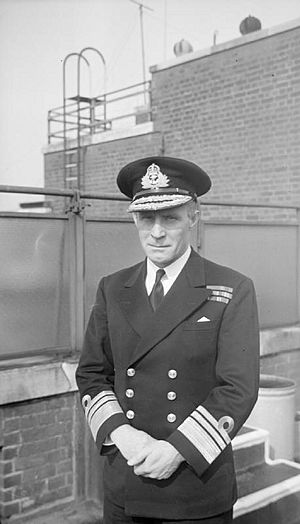Guy Royle facts for kids
Quick facts for kids
Sir Guy Charles Cecil Royle
|
|
|---|---|

Vice Admiral Royle as Chief of Australian Naval Staff during the Second World War
|
|
| Born | 17 August 1885 Esher, Surrey |
| Died | 4 January 1954 (aged 68) Ferndown, Dorset |
| Allegiance | United Kingdom |
| Service/ |
Royal Navy |
| Years of service | 1900–1946 |
| Rank | Admiral |
| Commands held | Chief of the Australian Naval Staff (1941–45) HMS Glorious (1933–34) HMS Excellent (1930–32) HMS Canterbury (1927–29) |
| Battles/wars | First World War Second World War |
| Awards | Knight Commander of the Order of the Bath Companion of the Order of St Michael and St George Legion of Merit (United States) Order of Orange-Nassau (Netherlands) |
Sir Guy Charles Cecil Royle (born August 17, 1885 – died January 4, 1954) was an important officer in the Royal Navy, which is the United Kingdom's navy. He later became a very senior leader in the Royal Australian Navy. He was known for his long service and leadership during both the First World War and the Second World War.
Contents
Guy Royle started his career in the Royal Navy in 1900. He was just 15 years old when he joined as a midshipman. This was the first step for young officers in the navy.
Serving in World War I
During the First World War, Royle was a Gunnery Officer. This meant he was in charge of the big guns on the battleship HMS Marlborough. He fought in the famous Battle of Jutland in 1916. This was one of the largest naval battles in history. After the battle, he worked for Admiral Sir Charles Madden.
By 1919, he had been promoted to a higher rank called commander. He also received an award called the Companion of the Order of St Michael and St George. This award was for his excellent work as a Gunnery Officer.
Between the Wars
After the First World War, Royle continued to rise through the ranks.
- In 1923, he worked in a department that dealt with naval weapons.
- In 1924, he became a Naval attaché in Tokyo, Japan. This role meant he represented the British navy in another country.
- He commanded several important ships and bases. These included the cruiser HMS Canterbury in 1927.
- He also commanded HMS Excellent, which was a training base, in 1930.
- Later, in 1933, he took command of the large aircraft carrier HMS Glorious.
From 1934 to 1937, he served as the Naval Secretary. This was an important job that involved managing naval affairs. By 1937, he was a Vice Admiral. He was put in charge of all the navy's aircraft carriers until 1939.
Leadership in World War II
When the Second World War began, Royle returned to duty.
- From September to November 1939, he briefly served again as Naval Secretary.
- After that, he became the Fifth Sea Lord. This was a very senior position in the Royal Navy. He was also Chief of the Naval Air Service, overseeing naval aircraft.
- In 1941, he moved to Australia. He became the First Naval Member of the Australian Commonwealth Naval Board. This meant he was the top leader of the Royal Australian Navy. He held this important role until 1945.
Royle was recognized for his service during the war. He was made a knight in 1941, which meant he could use "Sir" before his name. In 1942, he was promoted to the highest rank, Admiral. He retired from the navy in 1946.
After retiring from the navy, Sir Guy Royle took on some special ceremonial roles.
- He briefly worked as Secretary to the Lord Great Chamberlain.
- He also became the deputy of the Black Rod. This is a traditional job in the House of Lords, which is part of the British Parliament. He held this position from 1946 to 1953.
Sir Guy Charles Cecil Royle passed away on January 4, 1954. He collapsed while trying to put out a fire near his home in Wimborne Minster, England.

